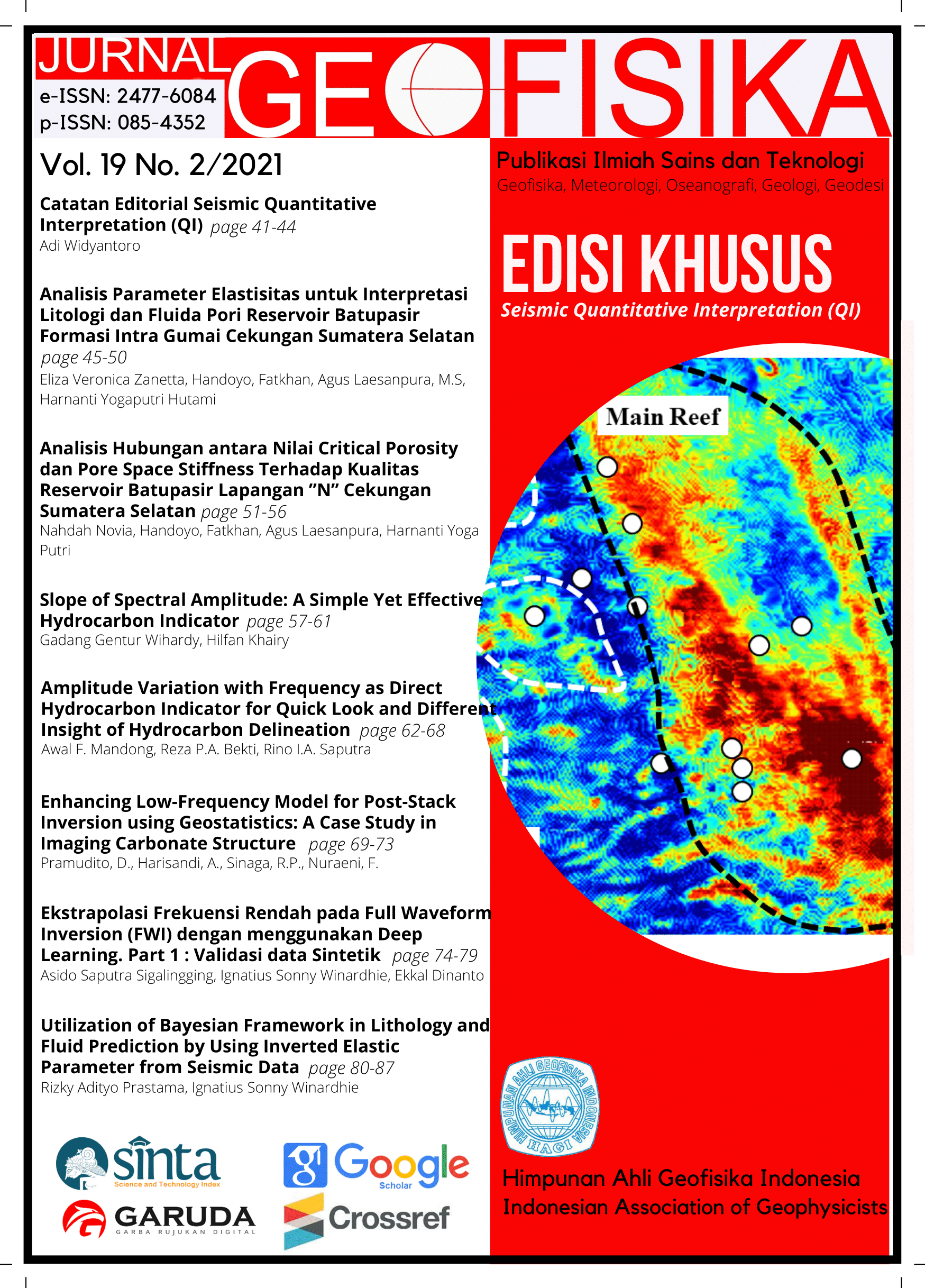Amplitude Variation with Frequency as Direct Hydrocarbon Indicator for Quick Look and Different Insight of Hydrocarbon Delineation
Keywords
Frequency gather, AVF, Spectral Decomposition, Time-frequency analysis, Amplitude Variation with FrequencyAbstract
One of the most common and established techniques to identify hydrocarbon presence is by analyzing the amplitude variation with offset (AVO) utilizing the pre-stack seismic data. However, the gather data quality even the availability of pre-stack data could often become an issue. When the seismic wave propagates through a highly attenuating medium (i.e. hydrocarbon-bearing reservoir), it loses its high-frequency content and the dominant frequency tends to slide to the lower frequency. These high-frequency loss phenomena can be used to delineate hydrocarbon-bearing reservoirs using spectral decomposition method. The continuous wavelet transform (CWT) is used to decompose seismic and generate the frequency gather data to analyze the frequency loss due to hydrocarbon presence using gradient analysis. The result from this study shows that the hydrocarbon-bearing zone correlates to the high attenuation is able to be delineated using the Amplitude Variation with Frequency (AVF) analysis method. The hydrocarbon anomaly observed from the AVF analysis result is aligned with the AVO analysis and validated by the water saturation log. The results of this study suggest that AVF analysis method can help to identify as a quick look approach and provide a better confidence level as a direct hydrocarbon indicator when combined with other direct hydrocarbon indicator methods such as AVO method.
References
Herrera, R.H., Han, J., Mirko, van der B., 2014. Applications of the synchrosqueezing transform in seismic time-frequency analysis. Geophysics 79, V55–V64.
Mayall, M.J., Yeilding, C.A., Oldroyd, J.D., Pulham, A.J. & Sakurai, S. 1992. Facies in a shelf-edge delta; an example from the subsurface of the Gulf of Mexico, middle Pliocene, Mississippi Canyon, Block 109. AAPG Bulletin, 76, 435-448.
Latimer, R.B., and van Riel, P. (1996) Integrated seismic reservoir characterization and modeling: a Gulf of Mexico 3D case history. GCSSEPM 1996 Research Conference.
Mulyani, R., Widiatmo, R., Gunawan, H., Nugroho., Hairunnisa., Mandong, A., and Saputra, R. (2018): New Approach: Using Relative Inversion with Spectral Decomposition to Distinguish Thin Layers in The 33-Series Sand Reservoirs of The Widuri Field, Southeast Sumatra, Indonesia. Proceedings of The 42nd of Indonesian Petroleum Association (IPA) Annual Convention and Exhibition.
Sinha, S.K., P.S. Routh, P.D. Anno, C. Phillips and J.P. Castagna, 2005. Spectral decomposition of seismic data with continuous-wavelet transform. Geophysics, 70: 19-25. DOI: 10.1190/1.2127113.
Sun, S., J. P. Castagna, and R. W. Seigfried, 2002, Examples of wavelet transform time-frequency analysis in direct hydrocarbon detection: 72nd Annual International Meeting, SEG, ExpandedAbstracts, 457–460.
Xia, X. G. (1998), A quantitative analysis of SNR in the short-time Fourier transform domain for multicomponent signals, IEEE Transactions on Signal Processing, 46, 200-203.

This work is licensed under a Creative Commons Attribution 4.0 International License.
The copyright of all articles belongs to the authors. All other copyrights is held by the Journal











